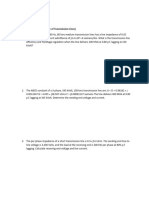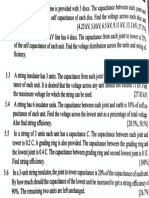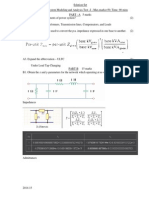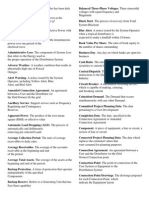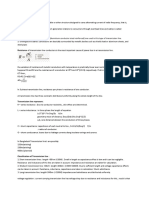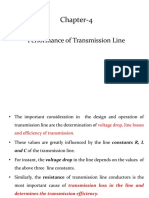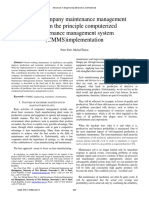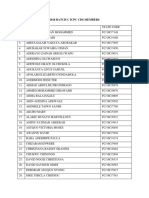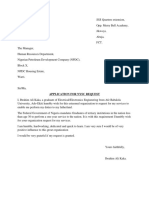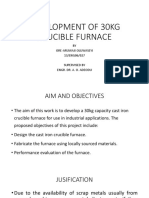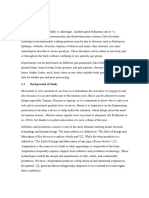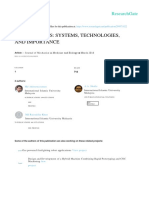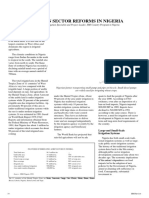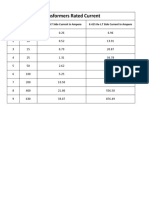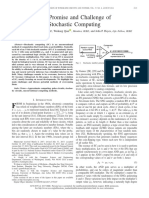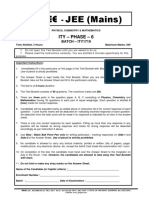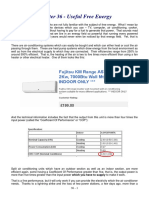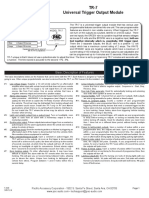Module 2: Characteristics of
Transmission Lines & Performance
�Introduction
Transmission line is important link between the generating
stations and distribution stations
Transmission lines are characterised by series resistance
(R), inductance (L) and shunt capacitance (C) per unit
length
The design and operation of transmission line depend on:
Voltage drop, line losses and efficiency
These quantities are dependent on the line parameters: R, L and
C of the line
Voltage drop is depended on all the parameters
R is the most important cause of power loss in the line and
determine the efficiency of the line
Prof. J O Dada
�Classification of Overhead Line
The transmission line parameters, R, L and C are
uniformly distributed along the whole length of the line
R and L combined to form the series impedance, Z
(Z=R+jXL)
Capacitance, C, forms a shunt path throughout the length
of the line. it exists between conductors for one-phase line
or from conductor to neutral for a 3-Phase line
Short transmission line
Length of overhead line is up to 80 km and voltage is less than
20kV
Effects of capacitance are small and can be neglected
Only resistance and inductance are taken into account
Prof. J O Dada
�Classification of Overhead Line
Medium transmission line
Length of overhead line is about 80-200 km and line voltage
is greater than 20 kV and less that 100 kV (>20 kV <100kV)
Capacitance effects are taken into consideration
Distributed capacitance of line is divided and lump in form of
condensers shunted across the line at one or more point
Long transmission line
Line length of overhead line is more than 200 km and line
voltage is very high(>100 kV)
Line parameters are considered uniformly distributed over
the whole length of the line
Prof. J O Dada
�Transmission Line Voltage Regulation
There is voltage drop in line due to resistance and
inductance of line in a current carrying transmission line
Receiving end voltage (VR) is less that than the sending
end voltage (VS)
Voltage regulation is the difference in voltage at the
receiving end of a transmission line between conditions
of no load and full load expressed as percentage of the
receiving end voltage
%Voltage Regulation=
V S V R
x 100
VR
Voltage regulation of line should be low. Increase in load
should have little difference in VR
Prof. J O Dada
�Transmission Line Efficiency
Power at the transmission line receiving end is
less than the the sending end power in most
cases due to losses on the line resistance
Efficiency is the ratio of receiving end power to
the sending end power of a transmission line
V R I R cos R
Receiving End Power
%Efficiency=
x 100=T =
x 100
Sending End Power
V S I S cos S
VR, IR and cosR are phase values of receivingend voltage, current and power factor, while
VS, IS and cosS are phase values of sendingend voltage, current and power factor
Prof. J O Dada
�Short Line Model
R
X
C
VS
VR
Load
IX
VS
Equivalent Circuit Diagram
IR
VR
O
VR sinR
S R
VRcosR
Phasor Diagram
Prof. J O Dada
(OC) =(OD) +( DC)
2
2
2
V s =(OE+ ED) +(DB+BC )
2
2
2
V S =(V R cos R +IR) +(V R sin R + IX )
IX
V S = (V R cos R + IR) +(V R sin R + IX )
OD V R cos R + IR
cos R =
=
OC
VS
2
VS
A
IR
VR
VR sinR
S R
E
D
Power delivered=V R I R cos R
VRcosR
2
Phasor Diagram
Line losses=I R
Power input =V R I R cos R + I 2 R
Power delivered
%Transmission Efficiency=
Power Input
V R I R cos R
%Transmission Efficiency=
V R I R cos R +I 2 R
V S V R
V R + IR cos R +IX sin R V R
%Voltage Regulation=
x 100
x 100
Prof. J O Dada
VR
VR
�Calculating VS Using Complex Notation
R
VR
VS
Load
VS
VR=V R + j 0
VR
I =I < R =I (cos R jsin R )
O
R
Z =R+ jX
VS =VR + I Z
VS =(V R + j 0)+I (cos R jsin R )( R+ jX )
VS =(V R +IR cos R +IX sin R )+ j (IX cos R IR sin R )
V S = (V R + IR cos R + IX sin R ) +(IX cos R IR sin R )
Neglecting second term
V S =V R + IR cos R + IX sin R
2
Prof. J O Dada
IZ
A
IX
IR
B
�Examples
Example 2.1
A single phase overhead transmission line delivers 1100 KW at 33 kV at 0.8
p.f. lagging. The total resistance and inductive reactance of the line are 10
ohms and 15 ohms respectively. Determine:
(i) sending end voltage
(ii) sending end power factor
(iii) transmission efficiency
Example 2.2
An overhead 3-phase transmission line delivers 5000 kW at 22 kV at 0.8 p.f.
lagging. The resistance and reactance of each conductor is 4 ohms and 6
ohms respectively. Determine:
(i) sending end voltage
(ii) percentage regulation
(iii) total line losses
(iv) transmission efficiency
Prof. J O Dada
�Nominal T-Network Model of Medium Line
R/2
IS
R/2
X/2
X/2
IR
VS
V1
Load
IC
VR
Equivalent Circuit Diagram
E
S
V1
IS
IR
IC
Phasor Diagram
VR
IRR/2
C
ISR/2
O
R
VS
IRX/2
B
Prof. J O Dada
ISX/2
D
�Nominal T-Network Model of Medium Line
IS
R/2
R/2
X/2
X/2
IR
VS
VR=V R + j 0
IR =I R (cos R jsin R )
V 1 =V R + I R
2
V1
VR
Load
IC
R
X
V 1 =V R + I R (cos R jsin R )( + j )
2
2
IC = j C V1 = j 2 f C V1
IS = IR + IC
Z
R
X
VS =V1 + IS =V1 + IS ( + j )
2
2
2
Prof. J O Dada
�Examples
Example 2.3
A transmission line of 200 km long has the following
constants:
Resistance per km = 0.15 ohms
Reactance per km = 0.50 ohms
Susceptance per km = 2.0 x 10-6 mho
Voltage at the receiving end is 132 kV. The
transmission line is delivering 50 MVA at 0.85 pf lagging
at the receiving end. Calculate the (I) the sending end
voltage (ii) sending end current (iii) voltage regulation
(iv) line efficiency. Use nominal T method
Prof. J O Dada
�Quiz
A single phase overhead line (10 km) delivers
2000 KW at 33 kV with 0.8 p.f. lagging. The
resistance and inductive reactance per km of
the line are 1.0 ohms and 1.5 ohms
respectively. Determine:
(i) sending end voltage
(ii) sending end power factor
Prof. J O Dada
�Nominal -Network Model of Medium Line
R
IS
IR
IC2
VS
C/2
Load
IC1
VR
C/2
Equivalent Circuit Diagram
VS
IZ
IS
I
IR
VR
IR
IC2
IC1
Phasor Diagram
Prof. J O Dada
IX
�Nominal -Network Model of Medium Line
R
IS
IR
IC2
VS
C/2
C/2
VR=V R + j 0
IR =I R (cos R jsin R )
C
IC 1 = j VR = j f C VR
2
I = IR + IC 1
VR
Load
IC1
VR + I (R+ jX )
VS =VR + IZ=
C
I C 2 = j V S = j f C VS
2
IS =I + IC 2
Prof. J O Dada
�Examples
Example 2.4
A 50 Hz, 3-phase transmission line 100 km has a
total series impedance of (40+j125) ohms and
shunt admittance of 10-3 mho. The load is 50 MW at
220 kV with 0.8 lagging power factor. Use nominal
model to find the sending end voltage, current and
power factor.
Prof. J O Dada
�Analysis of Long Transmission Lines
IS
VS
zdx
V + dV
ydx
dx
dx = infinitely small length of the line at a
distance x from the receiving end
V = voltage per phase at the end of
element towards receiving end
V + dV = voltage per phase at the end of
element towards sending end
IR
VR
Load
I + dI
x
l
I + dI = currrent entering element dx
I = current leaving the element dx
z = impedance per unit length of line
y = admittance of unit length of line
Prof. J O Dada
�Model of Long Transmission Line
Voltage drop across element dx is given by
dV =Izdx
dV
=Iz
dx
Current drawnby the element dx
dI=Vydx
dI
=Vy
dx
2
d V zdI
=
2
d x dx
Substitute
dI
=Vy , we have
dx
2
dV
=zVy
2
d x
A linear differential equation
General solution is given by
V =A 1 e yz x + A 2 e yz x
A 1 , A 2 are arbitrary constant
differentiate V ,w .r .t . x
dV
= A 1 e yz x A 2 e yz x
dx
1 dV 1
I=
= yz { A 1 e yz x A 2 e yz x }
z dx z
y
I= { A 1 e yz x A 2 e yz x }
z
y
ZC=
is the characteristic impedance
z
= yz is the propagation constant
Prof. J O Dada
�Model of Long Transmission Line
At the receiving end, x=0, V=VR and I=IR
After substituting the boundary conditions
and solving for A1 and A2, the expressions
for V and I are given by:
1
x 1
x
V = [V R +I R Z C ]e + [V R I R Z C ]e
2
2
1 VR
1 VR
x
x
I=
+I R e
I R e
2 ZC
2 ZC
[( ) ] [( ) ]
Rearranging the two expressions
V =V R cosh x+I R Z C sinh x
VR
I=I R cosh x+ sinh x
ZC
The sending-end voltage and the
sending-end current are obtained
by putting x=l
V S=V R cosh l+I R Z C sinh l
VR
I S =I R cosh l+ sinh l
ZC
l= yzl= yl zl= YZ
Z=total impedance of the line
Y =total admittance of the line
Hence ,
V S=V R cosh YZ+I R Z C sinh YZ
VR
I S =I R cosh YZ+ sinh YZ
ZC
Power series expansion
2 2
ZY Z Y
cosh YZ= 1+ +
+.....
2 24
Prof. J O Dada
3
2
(Y Z)
sinh YZ= YZ+
+......
6
�Model of Long Transmission Line
Surge impedance (Z0)
Is the characteristic impedance of a loss-free line
For heavy copper conductor and well insulated line, the resistance, R and leakage
conductance G can be neglected
Z C=
Overhead line
Z0 varies between 400 and 600
Underground cables
Z
R+ jX
jX
L
=
=
=Z 0 =
Y
G+ jB
jB
C
Z0 varies between 40 and 60
Z0 can be obtained by measuring the line impedance at the sending end
when
(i) the line at the receiving end is open-circuited
(ii) the line at the receiving end is short-circuited
Z 0 = Z OC Z SC
Z OC =open circuit impedance
Z SC =short circuit impedance
Prof. J O Dada
�Model of Long Transmission Line
Propagation for loss free line is given by
= ZY =( R+ jX )(G+ jB)= jX jB= jw LC= j
is the phase shift
It determines the torque angle between VS and VR and hence system stability
Example 2.5
A three phase transmission line 200 km long has the
following constants:
Resistance/phase/km= 0.16 ohms
Reactance/phase/km = 0.25 ohms
Shunt admittance/phase/km = 1.5x10-6 S
Using long line model, calculate the sending end voltage and
current when the line is delivering a load of 20 MW at 0.8 pf.
Lagging. The receiving end voltage is kept constant at 110 kV
Prof. J O Dada
�Generalised Circuit Constant
Transmission line is a 4-terminal network
Two port network
Two input terminals where power enters the network
Two output terminals where power leaves the network
Input voltage and input current can be expressed in terms of
output voltage and output current
IS
VS
IR
ABDC
VR
V S = AV R +BI R
I S =CV R + DI R
A, B, C and D are complex numbers
A & D are dimensionless while B & C have dimension of ohms and
siemen respectively
For a given transmission line
A=D
AD - BC = 1
Prof. J O Dada
�Determination of Generalised Constants
IRZ
Short lines
I S =I R +YV R +Y
V S = AV R +BI R
2
V S =V R + I R Z
I S =CV R + DI R
YZ
I
=YV
+
I
1+
I S =I R
S
R
R
2
IRY IS Y
A=1, B=Z , C=0, D=1
V S =V R +
+
2
2
A=D
Substitute the value of I S
ADBC=1 x 1Z x 0=1
Medium line Nominal T method
Z
V S =V 1 + I S
2
Z
V 1 =V R + I R
2
IR Z
I C =I S I R =V 1 Y =Y V R +
2
) (
YZ
YZ
V S = 1+
V R+ Z +
IR
2
4
Comparing with generalised equations
YZ
YZ
A=D= 1+
; B=Z 1+
;C=Y
2
4
) (
YZ
YZ
ADBC= 1+
Z 1+
Y =1
2
4
Prof. J O Dada
�Determination of Generalised Constants
Assignment
Derive the ABCD constants for medium line nominal
method
Example 2. 6
A three phase overhead transmission line has a total series
impedance per phase of 200<800 ohms and a total shunt
admittance of 0.0013 <900 mho per phase. The line delivers
a load of 80 MW at 0.8 power factor lagging and 220 kV
between the lines. Using a nominal T model, calculate
(i) the ABCD constants of the line
(ii) the sending-end voltage, current and pf of the line
(iii) the efficiency of transmission
Prof. J O Dada
�Determination of Generalised Constants
Long line
V S=V R cosh YZ +I R
I S =V R
Z
sinh YZ
Y
Y
sinh YZ +I R cosh YZ
Z
A=D=cosh YZ
Z
B=
sinh YZ
Y
Y
C=
sinh YZ
Z
Prof. J O Dada
V S = AV R +BI R
I S =CV R + DI R
�References
[1] D. P. Kothari & I. J. Nagarath, Modern
Power System Analysis
[2] J. B. Gupta, A Course in Power Systems
[3] J. B. Gupta, Transmission and Distribution of
Electrical Power
[4] Department of Electrical Engineering , India,
Odisha Lecture Notes on Power System
Engineering II
[5] Performance of Transmission lines (Internet)
Prof. J O Dada


